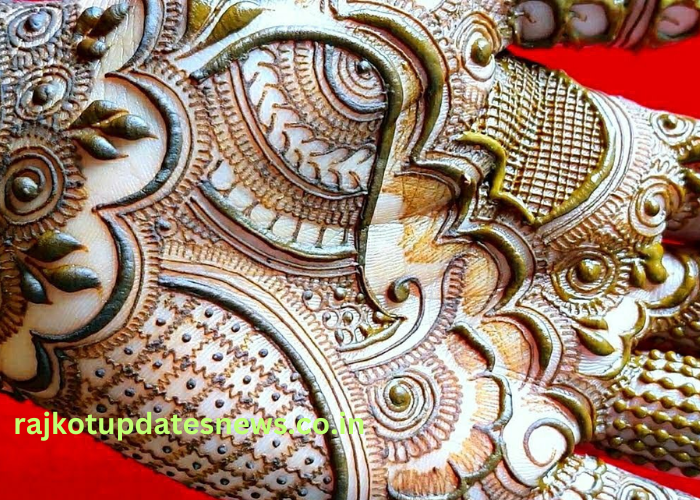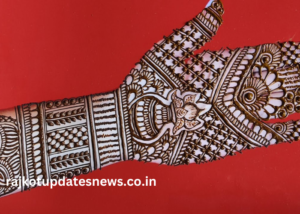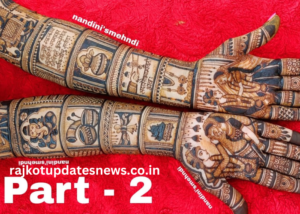
Bridal mehndi is a timeless tradition in many cultures, especially in South Asia, where it is applied to the bride’s hands and feet as part of her wedding celebration. The dulhan:8j62heuynew= Bridal Mehndi Design stands out for its elaborate patterns, rich symbolism, and significance to the bride’s journey into married life.
In recent years, this traditional art form has evolved into a blend of contemporary and classic designs, offering brides an opportunity to express their personality and style while staying connected to cultural roots. The dulhan:8j62heuynew= Bridal Mehndi Design not only beautifies but also carries deep cultural and personal meaning, making it an essential part of the wedding festivities.
What Makes the dulhan:8j62heuynew= Bridal Mehndi Design Special?
The dulhan:8j62heuynew= Bridal Mehndi Design is more than just an art form; it is a cultural symbol that holds great significance for brides in many cultures. The design is believed to bring good fortune, prosperity, and happiness to the newlywed couple. It is a symbol of the bride’s connection to her family, culture, and her new life as a wife.
What sets this particular design apart is its intricate nature, which often covers the hands and feet entirely. The use of detailed floral patterns, peacocks, paisleys, and geometric shapes adds depth and beauty to the overall look. Each element in the dulhan:8j62heuynew= Bridal Mehndi Design holds symbolic meaning. For instance, paisleys are considered a symbol of fertility, while peacocks represent beauty and grace, making the design a meaningful choice for brides.
Additionally, the dulhan:8j62heuynew= Bridal Mehndi Design often includes hidden motifs that are personal to the bride and groom, such as initials, wedding dates, or even depictions of their love story. These personal touches make the design unique and deeply sentimental.
How Long Does It Take to Apply the dulhan:8j62heuynew= Bridal Mehndi Design?
The application of the dulhan:8j62heuynew= Bridal Mehndi Design is a time-consuming process that requires precision and skill. On average, it takes anywhere from three to six hours to complete, depending on the complexity of the design. Brides often choose to have their mehndi applied a day or two before the wedding to allow it to dry and develop its rich color.
The dulhan:8j62heuynew= Bridal Mehndi Design covers not just the hands but also the forearms, and in some cases, the feet, making the process even longer. The artist carefully applies each section of the design to ensure every detail is perfectly executed. Some designs can be so intricate that they require hours of concentrated work, with the artist carefully following the contours of the bride’s hands and arms to create a seamless flow of patterns.
After the henna paste is applied, it is left to dry for several hours before being scraped off, revealing the deep, reddish-brown stain. The stain gradually darkens over the next 24 to 48 hours, giving the dulhan:8j62heuynew= Bridal Mehndi Design its lasting beauty.
What Are the Most Popular Patterns in the dulhan:8j62heuynew= Bridal Mehndi Design?
The dulhan:8j62heuynew= Bridal Mehndi Design is known for its intricate and symbolic patterns that are rich in meaning. Some of the most popular motifs used in these designs include floral patterns, paisleys, peacocks, and mandalas. Each of these elements carries its own significance and adds to the overall meaning of the design.
Floral designs are often the focal point in a dulhan:8j62heuynew= Bridal Mehndi Design, symbolizing beauty, femininity, and new beginnings. These floral patterns are usually interwoven with delicate vines and leaves, creating a flowing design that symbolizes the bride’s growth and journey.
Paisleys are another prominent feature, symbolizing fertility, abundance, and good fortune. They are often placed strategically within the design to represent the bride’s wish for a prosperous marriage. Peacocks, with their elegant feathers and vibrant colors, are commonly incorporated as a symbol of beauty and grace, adding a regal touch to the dulhan:8j62heuynew= Bridal Mehndi Design.
Lastly, mandalas are increasingly popular in bridal mehndi designs. The mandala, with its intricate circular patterns, represents unity, eternity, and the spiritual journey, making it a perfect addition to the dulhan:8j62heuynew= Bridal Mehndi Design.
How Can You Make Your dulhan:8j62heuynew= Bridal Mehndi Design Unique?
One of the most beautiful aspects of the dulhan:8j62heuynew= Bridal Mehndi Design is its flexibility and the ability to personalize it. Brides can make the design truly their own by incorporating unique elements, such as personal symbols, initials, or specific motifs that hold special meaning to them.
For example, some brides choose to add their partner’s initials or even small pictures depicting their love story within the design. Hidden symbols, such as the groom’s name or a meaningful date, can also be subtly incorporated into the design. This adds a layer of personal connection, making the dulhan:8j62heuynew= Bridal Mehndi Design even more meaningful.
In addition to personal touches, brides can also experiment with modern trends in mehndi, such as using colored henna or adding intricate geometric patterns. Colored henna, in shades like red, gold, or white, can make the design pop and give it a contemporary flair. The use of negative space, where parts of the skin are left blank, is another trend that can create a striking contrast and add modern elegance to the design.
How Do You Care for the dulhan:8j62heuynew= Bridal Mehndi Design After Application?
Proper aftercare is essential to ensuring that the dulhan:8j62heuynew= Bridal Mehndi Design stays vibrant and lasts as long as possible. After the henna paste is applied, it should be allowed to dry completely, which usually takes a few hours. To preserve the stain and ensure it becomes darker, many brides apply a mixture of lemon juice and sugar to the design once the paste has dried.
It is crucial to avoid any water contact during the first few hours after the paste has dried, as this can cause the design to fade prematurely. After the paste is scraped off, the henna stain will continue to darken for the next 24 to 48 hours, reaching its deepest color.
Additionally, to prevent the design from fading too quickly, the bride should avoid scrubbing the areas where the dulhan:8j62heuynew= Bridal Mehndi Design is applied. Moisturizing the skin with natural oils such as coconut oil can help preserve the design and keep the skin hydrated.
How Much Does a dulhan:8j62heuynew= Bridal Mehndi Design Cost?
The cost of a dulhan:8j62heuynew= Bridal Mehndi Design can vary significantly depending on several factors, such as the complexity of the design, the location of the mehndi artist, and their experience. On average, brides can expect to pay anywhere from $100 to $500 for a bridal mehndi session.
For more intricate and elaborate designs, the price can go higher. Bridal mehndi artists often charge more for designs that cover both hands and feet with detailed patterns. The dulhan:8j62heuynew= Bridal Mehndi Design can take several hours to complete, which also contributes to the cost.
It is important to consult with the artist beforehand and discuss the price based on the complexity of the design. Brides should also factor in any additional costs for travel or any special requirements for the design.
How Do You Choose the Right Artist for Your dulhan:8j62heuynew= Bridal Mehndi Design?
Choosing the right artist for your dulhan:8j62heuynew= Bridal Mehndi Design is essential to ensuring a beautiful and flawless result. When selecting a mehndi artist, it is important to look for someone with experience and a portfolio of bridal designs that resonate with your vision.
A skilled mehndi artist should be able to understand your preferences and create a design that aligns with your style. Browsing the artist’s previous work online or asking for recommendations from friends and family can be a great way to ensure you choose the right artist for your dulhan:8j62heuynew= Bridal Mehndi Design.
It is also recommended to book a trial session before the wedding to see how the artist works and make sure you are satisfied with their skill and style.
What Are Some Modern Trends in dulhan:8j62heuynew= Bridal Mehndi Design?
While the dulhan:8j62heuynew= Bridal Mehndi Design is rooted in tradition, modern trends have brought new dimensions to this beautiful art form. Brides are increasingly opting for contemporary styles that blend traditional motifs with modern twists, creating a unique and personalized look.
Some of the latest trends in bridal mehndi include the use of colored henna, intricate geometric patterns, and even the incorporation of temporary metallic tattoos to complement the design. These trends add a fresh, innovative flair to the traditional dulhan:8j62heuynew= Bridal Mehndi Design while still maintaining its cultural significance.
Brides are also exploring the use of negative space in mehndi designs, where certain areas of the hands and feet are left blank to create a stunning contrast with the intricate patterns. These modern touches can elevate the overall look and make the dulhan:8j62heuynew= Bridal Mehndi Design even more striking.
Conclusion
The dulhan:8j62heuynew= Bridal Mehndi Design is a perfect blend of tradition and artistry, symbolizing a bride’s new beginnings, happiness, and prosperity. With its rich history and ever-evolving designs, it continues to be an integral part of wedding celebrations. By choosing the right artist and design, brides can ensure that their mehndi not only looks beautiful but also represents their personal style and cultural heritage.


